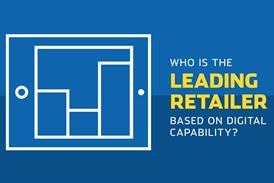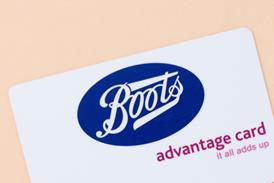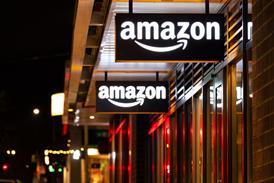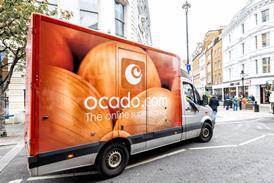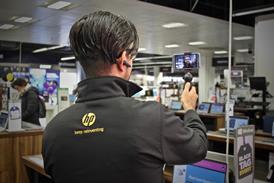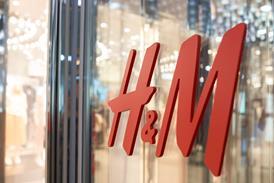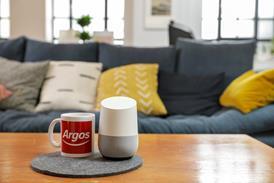- Rankings
- Marketing
- Logistics & customer service
- Cross-channel
- Ecommerce
 Evri reports 30% increase in US parcel deliveries as postal firms pause shipments
Evri reports 30% increase in US parcel deliveries as postal firms pause shipments Q&A: New boss of H&M-backed Centra Sara Laurell wants to keep the growth coming
Q&A: New boss of H&M-backed Centra Sara Laurell wants to keep the growth coming Why retail is lagging behind other sectors in AI investment
Why retail is lagging behind other sectors in AI investment Q&A: Currys Business’ Dean Kramer on growing brand awareness to reach more UK firms
Q&A: Currys Business’ Dean Kramer on growing brand awareness to reach more UK firms
- Case studies
- Methodology
Marketing
A retailer’s approach to marketing was considered to assess efforts in raising brand awareness and customer engagement.
In digitally-led retail, marketing decisions are not only key for brand exposure but for aiding frictionless shopping experiences that bolster competitiveness. As brand loyalty among customers diminishes, retailers must adapt by investing in digital marketing initiatives that are innovative and support personalisation.
Top 12 leading retailers in the marketing category
| Rank | Retailer | % |
|---|---|---|
| 1 | Morrisons | 82.7 |
| 2 | Marks & Spencer | 80.0 |
| 3 | Boots | 78.7 |
| 4 | Game | 78.7 |
| 5 | Matalan | 78.7 |
| 6 | Tesco | 78.7 |
| 7 | Ocado | 77.3 |
| 8 | Asos | 76.0 |
| 9 | Childrensalon | 73.3 |
| 10 | H&M | 73.3 |
| 11 | John Lewis | 73.3 |
| 12 | Superdrug | 73.3 |
Loyalty programmes are key for retention
Customer data is central to retail success, and loyalty schemes are a great way of gathering data across channels, helping to provide a single view of the customer. While this enables a more complete understanding of customer behaviour, retailers need to continue to provide innovation in their loyalty schemes to drive engagement.
For instance, Boots’ Advantage card scheme, which has 16 million active members, has continued to evolve. The health and beauty giant relaunched its app in early 2017 with access to personalised offers based on a customer’s purchasing history. Additionally, its Over 60s and Parenting Club extensions to the scheme feature exclusive offers, gifts and personalised emails to drive sales among key customer segments. These developments have been integral to its leadership in the health and beauty sector, and could be a lesson for rivals like Lush and Allbeauty.
The ability to create targeted offers through loyalty schemes helps drive retention, yet only a third of retailers offer one, while under 15% have a loyalty app.
Importance of social media and engaging content
Harnessing the power of social media further supports loyalty and customer acquisition. As customers become more promiscuous, exploiting social media can enable retailers to remain front-of-mind – driving traffic both online and in store.
Without a transactional online presence, Primark instead uses social media to stimulate interest among its c.11 million followers to drive footfall in-store. Frequently posting inspiration from its product range, with clear visibility of its low prices – one of the eminent differentiators for its success – enables Primark to capture the customer’s attention and propel its reach.
Primark also uses social media channels to prompt its customers to visit editorial content on its website, ensuring customers can see more of the range.
Retailers are also leveraging social media for direct sales. Customers can now go directly from being inspired by an item on Instagram or Facebook to viewing it on the retailer’s website in a single click – removing friction for customers.
In late 2017, John Lewis became the first retailer in the UK to trial virtual reality 360-degree video shoppable adverts on Facebook as part of its autumn campaign, supporting its strategy to offer customers “more inspiring experiences both in shops and online”.
Retailers are increasingly creating inspirational content online to bolster engagement and boost dwell time, with as many as 90% offering this as standard. Many in the grocery sector have taken this idea into the physical world, offering recipe cards in-store to drive average basket values, and to compete with recipe subscription services like Hello Fresh and Gousto.
SEO and retargeting
SEO and retargeting are critical steps in securing sales in the digital age. Retailers are dependent on perfecting their SEO to increase brand exposure, with SEO driving 84% of web traffic on average across the retailers assessed.
Amazon has invested heavily in this, ensuring its broad product range is more visible and accessible to customers than its competition – a huge advantage in an era of dwindling brand loyalty.
In 2017, Victorian Plumbing stated it invested over half of its marketing budget in SEO to climb the ranks on Google and other search engines, contributing to its status as the UK’s most visited online bathroom retailer the same year.
Google Shopping is proving common practice too, helping 75% of retailers broaden their reach while removing another layer in search by providing retailers’ product images directly in its search results. It is particularly useful for department stores, as generic product search terms can return sponsored results at non-specialists, boosting exposure.
When done right, retargeting can reignite brand exposure too. When content is tailored towards customers’ interests, email retargeting helps refine the information they receive, and is useful when basket abandonment rates are high. Made.com recently partnered with Criteo to implement a personalised email retargeting programme, which boosted remarketing revenue by 36%.
The use of email retargeting is widespread, with 52% of retailers implementing it as part of their marketing mix, compared with 35% that use online retargeting.
CASE STUDY
Morrisons makes loyalty simple
In October 2015, just six months into his reign as Morrisons chief executive, David Potts axed the retailer’s complicated Match & More price matching scheme.
The loyalty programme broke new ground by pledging to match the prices of discount duo Aldi and Lidl, as well as those of its big four rivals. But the initiative rewarded shoppers through a complex points system, rather than tangible money-off coupons, leaving shoppers confused as to whether or not they were actually getting a good deal

By contrast, More Card, which it launched in June 2016, is a simpler scheme that offers customers a £5 voucher for every 5,000 points accumulated from their shopping. It has proven a hit over the past two years – and was central to Morrisons’ triumph in the marketing category of the Retail Week Indicator.
“The data from our More Card helps us understand how we can improve the shopping trip store by store,” Morrisons marketing director Mark Hoban says. “It’s a very important way to listen to our customers, allowing us to better tailor our offer to meet our customers’ needs.”
Off the back of the customer insight garnered through More, Morrisons has successfully developed a sharper pricing architecture, tweaked ranges in stores based on hyper-local demand and provided shoppers with personalised rewards – all of which have been key to its wider turnaround.
Central to this personalisation has been the More Card’s accompanying smartphone app, which allows users to add their local store and see offers only available at that shop.
Simple processes and compelling content
Beyond its loyalty scheme, Morrisons customers can also create an account online using their Facebook account, removing a layer of complexity involved in setting up new accounts and passwords.
The Bradford-based grocer is one of the only food retailers to include such functionality, but Hoban says: “We are following the customer as they change their behaviour, recognising that social media is an important tool in our customers’ lives. It makes it easier to shop with us.”
Morrisons also scored highly for leveraging the power of online editorial content, uploading a greater number of recipe ideas over the past year, alongside links that allow customers to instantly shop for related ingredients.

Hoban highlights the importance of such content to engage with shoppers and drive spending.
“It enables customers to search hundreds of inspirational products and recipes for the food we make and provide, and find out useful information about our stores and the products and services they offer,” he explains.
“It also gives us a vehicle to talk about subjects that customers tell us are important to them, such as reducing food waste, tackling plastic and our support for various charitable causes such as CLIC Sargent.”
As other retailers seek to streamline their marketing functions, Morrisons has leveraged its team to great effect.



